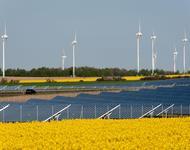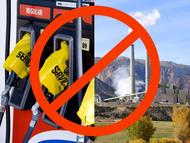Climate Change
Two days before Halloween, 2011, New England was struck by a freak winter storm. Heavy snow descended onto trees covered with leaves. Overloaded branches fell on power lines. Blue flashes of light in the sky indicated exploding transformers. Electricity was out for days in some areas and for weeks in others. Damage to property and disruption of lives was widespread.
That disastrous restriction on human energy supplies was produced by Nature. However, current and future energy curtailments are being forced on the populace by Federal policies in the name of dangerous “climate change/global warming”. Yet, despite the contradictions between what people are being told and what people have seen and can see about the weather and about the climate, they continue to be effectively steered away from the knowledge of such contradictions to focus on the claimed disaster effects of “climate change/global warming” (AGW, “Anthropogenic Global Warming”).
People are seldom told HOW MUCH is the increase of temperatures or that there has been no increase in globally averaged temperature for over 18 years. They are seldom told how miniscule is that increase compared to swings in daily temperatures. They are seldom told about the dangerous effects of government policies on their supply of “base load” energy — the uninterrupted energy that citizens depend on 24/7 — or about the consequences of forced curtailment of industry-wide energy production with its hindrance of production of their and their family’s food, shelter, and clothing. People are, in essence, kept mostly ignorant about the OTHER SIDE of the AGW debate.
Major scientific organizations — once devoted to the consistent pursuit of understanding the natural world — have compromised their integrity and diverted membership dues in support of some administrators’ AGW agenda. Schools throughout the United States continue to engage in relentless AGW indoctrination of students, from kindergarten through university. Governments worldwide have been appropriating vast sums for “scientific” research, attempting to convince the populace that the use of fossil fuels must be severely curtailed to “save the planet.” Prominent businesses — in league with various politicians who pour ever more citizen earnings into schemes such as ethanol in gasoline, solar panels, and wind turbines — continue to tilt against imaginary threats of AGW. And even religious leaders and organizations have joined in to proclaim such threats. As a consequence, AGW propaganda is proving to be an extraordinary vehicle for the exponential expansion of government power over the lives of its citizens.
Reasoning is hindered by minds frequently in a state of alarm. The object of this website is an attempt to promote a reasoned approach; to let people know of issues pertaining to the other side of the AGW issue and the ways in which it conflicts with the widespread side of AGW alarm (AGWA, for short). In that way it is hoped that all members of society can make informed decisions.
Climate Change News
Thorough analysis by Clintel shows serious errors in latest IPCC report - Highlighted Article
- 6/22/23 at 07:00 AM
Social Cost of Preferences - ORIGINAL CONTENT
- 6/20/23 at 07:00 AM
The Real Climate Crisis - Alex Epstein - Highlighted Video
- 6/15/23 at 07:00 AM
Social Cost of Mandates - ORIGINAL CONTENT
- 6/13/23 at 07:00 AM
150 Ways the Biden Administration and Democrats Have Made it Harder to Produce Oil & Gas - Highlighted Article
- 6/8/23 at 07:00 AM
Social Cost of Subsidies - ORIGINAL CONTENT
- 6/6/23 at 07:00 AM
Is AR6 the worst and most biased IPCC Report? - Highlighted Article
- 6/1/23 at 07:00 AM
Goals & Plans - ORIGINAL CONTENT
- 5/30/23 at 07:00 AM
Fauci, Fear, Balance and the Grid - Highlighted Article
- 5/25/23 at 07:00 AM
What if ...? - ORIGINAL CONTENT
- 5/23/23 at 07:00 AM
Silence of the Grid Experts - Highlighted Article
- 5/18/23 at 07:00 AM
Climate & Fairy Tales - ORIGINAL CONTENT
- 5/16/23 at 07:00 AM
Renewable Experts: Undeterred and Unmoved by Failed Ideas - Highlighted Article
- 5/11/23 at 07:00 AM
Paths to Net Zero - ORIGINAL CONTENT
- 5/9/23 at 07:00 AM
The State of the Climate 2022 - Highlighted Article
- 5/4/23 at 07:00 AM
-
Headlines
Search Headlines-
Google Bets Big On Nuclear Fusion
- ZeroHedge
- July 7, 2025
-
U.S. “renewables” mad scramble to build is on
- CFACT
- July 7, 2025
-
Stop These Things’ Weekly Round Up: 6 July 2025
- Stop These Things
- July 6, 2025
-
The Iberian Blackout -The Reports
- Kilovar's Substack
- July 6, 2025
-
Where the fight against energy subsidies stands, by Alex Epstein
- Thoughts About Energy and Economics - Substack
- July 6, 2025
-
Ocean “Reversal” Hysteria: Facts Not Included
- Watts Up With That
- July 6, 2025
-
Green Energy Provisions In The One Big Beautiful Bill Act: Unfortunately, A Mixed Bag
- Manhattan Contrarian
- July 6, 2025
-
The "Baseload" Solar Beatdown
- Energy Bad Boys - Substack
- July 5, 2025
-
Climate change causes WHAT!!? Pink lakes, divorcing albatrosses, shrinking goats and lots else
- Reef Rebels
- July 5, 2025
-
From Carney to Congress: the global revolt against Net Zero takes shape
- Net Zero Watch
- July 4, 2025
-
Why Your EV Won’t Fill Up In Five
- Watts Up With That
- July 4, 2025
-
“We hold these truths to be self-evident, that” there is no energy transition!
- Watts Up With That
- July 4, 2025
-
Inter-American Court Rules Nations Must Reduce Emissions and Censor Skeptics
- Watts Up With That
- July 4, 2025
-
Suddenly 1.5 million square km of sea ice is missing near Antarctica and all the climate models were wrong
- JoNova
- July 4, 2025
-
“The ‘Climate Crisis’ vs the REAL Crisis Facing Americans: News Media Journalism Malfeasance”
- Cornwall Alliance
- July 2, 2025
-
The End of the Green Panic
- Real Clear Energy
- July 1, 2025
-
-
Scholars Wanted
 The Right Insight is looking for writers who are qualified in our content areas.
The Right Insight is looking for writers who are qualified in our content areas.


















